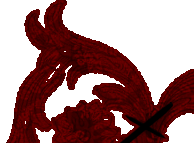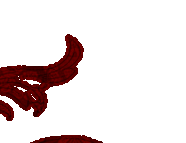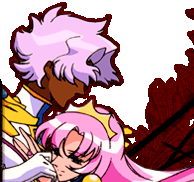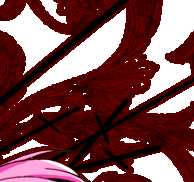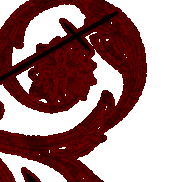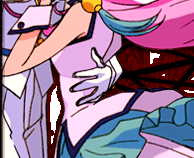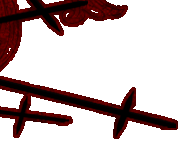
This analysis
was donated by Khalix. 
Revolutionary Girl Utena is anime series that shaped the later part of my teenage hood and dominated a large portion of my adulthood. I always felt that there is more to the story of Utena. Not only are the characters psychologically expansive and deep but their actions are quite compelling. Utena was one of the first shows to show passivity as a force of nature. This is before Judith Butler wrote her crucial work Notes Toward a Performative Theory of Assembly (2015). Utena certainly embodies her seminal work Gender Trouble (1990) through in its way of showing the interchangeable and non-innate functions of genders. Utena, plays all the functionaries of princess, damsel and prince, with effective repercussions. Anthy, in her passivity is both princess and witch; soon, she also arises as a prince of a different mould. The series obviously is an experimental and experiential vivisection of the labels prince, princess, witch, damsel, noble and commoner. There is something exceptional in how the series breaks down all of these roles to their anatomical bits and shows that each character’s nakedness can be aligned and share a similarity with each other. Labels are not cynosural — they can be expanded and have addendums fit into them.
Chiho Saito returns after 20 years to give us just that. A more elaborative story of Utena, structurally, physically, psychologically, spiritually, semiotically and symbolically. The semiotic threads that joined the manga, anime series, Adolescence Apocalypse movie and its spiritual succeeding manga are all combined to create a new morphology based on the foundations of the old incarnations. Utena thrives and evolves over the ages. Though it takes both Modernism and Postmodernism as its edicts, it can supersede them. If Utena is not always interested in origins it still has half-origins and half-closures in them — in this way it defeats the Grand Narrative of Modernism and also annexes the need for non-beginning and non-endings from Postmodernism. Origins and Closures can have their own benefits as long they do not fall under a totality and totalising effect. In this tradition, Saito once again embarks on the universe of Utena. There is much to be said about this universe. There are some pressing questions to the narrative as well. However, it builds very organically into all the incarnations we have seen so far. This is Saito’s author’s talent, her genius in making even a fragmented reality have a cohesion without a totalising effect.
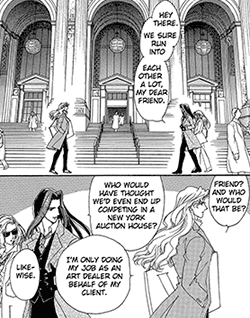
The readers are introduced to Touga and Saionji as adults. They still seem to have a tensed relationship. Though it is clear, as the manga progresses, that they don’t recollect why. This is in conjunction to the end of the Utena manga where everyone, except a few, do not recollect Utena or the duels anymore. Touga and Saionji seem to be rivals yet again in the world of adulthood. They are competing in securing art dealerships. Some things have changed, whereas others have not. Touga is shown to still be a womaniser. Saionji is still stoic and unreadable. If he lacks Touga’s charisma he makes up for it by being conscientious and focused. It is Saionji who struck me as the more matured person. This is quite telling, seeing in the series he lacked Touga’s vulpine machinations and was more naïve and impulsive. Saionji loved boldly and honestly to the point it caused an excess that was destructive to others and self-destructive. Saionji has polished his honesty and made it into a refined calm. He does not seem to think Touga as his friend. It is true that their friendship was never ideal. In this sense, it seems Saito is asking if any friendship truly is. Touga still hides behind smiles, charm and women. There are obviously things about himself he readily does not wish to face. It is this that we see manifest as the manga continues.
Touga and Saionji are then given the rose signet sealed letters to once more go to Ohtori Academy. They do not understand why but the place holds for them a sense of awe and a sense of dread. They are looking for the lost painting of the Chairman, his hidden masterpiece called “The Revolution.” Both of them know the secret passage to the Chairman’s estate as they are once part of the Student Council. That they remember; the significance they have forgotten. They discuss that “The Revolution” was the Chairman’s picture of his beloved sister. They also see a picture of the chairman and his sister. 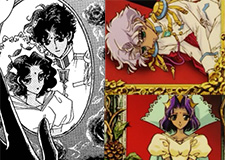
This picture may seem familiar because it is almost like these pictures from Adolescence Apocalypse. (See right.)
Their casing of the Chairman’s offices is interrupted by the Chairman himself. Akio tells Touga and Saionji that “The Revolution” is an important piece to him and that someone is trying to steal it. They can have all of his earthly riches as long as they protect “The Revolution.” Confused both Saionji and Touga see t a sword flies through the Chairman making him vanish. It is at this time that Saionji and Touga touch the sword and go back to their childhood. The childhood that possesses Utena and had set them on track all this time. After coming back to their senses, Touga receives a call from the artist, Rime. Saionji doesn’t wish to do business with such a man because he is hinted to be involved in paedophilia and pederasty. The subjects of Rime’s works are children who are said to be abused. 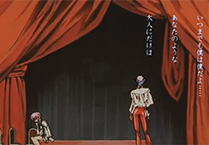 Touga remains unfazed. His answer to Saionji is that the art of the man matters and not the man’s moral leanings. Touga says that morality is ultimately a construct of society and that Rime may not be lauded now but he surely will be lauded in the future when society changes their tunes. This completely shocks Saionji. He had not anticipated for Touga to act so callous and selfish. The scene can be juxtaposed with the deleted teaser scene of the movie where Utena angrily screams at Akio that she will not become an adult like him. In a horrible twist of Fate, Touga has become more like Akio than he has realised. He believes in profits and he believes in utilising people for his end goals. Touga remains unfazed. His answer to Saionji is that the art of the man matters and not the man’s moral leanings. Touga says that morality is ultimately a construct of society and that Rime may not be lauded now but he surely will be lauded in the future when society changes their tunes. This completely shocks Saionji. He had not anticipated for Touga to act so callous and selfish. The scene can be juxtaposed with the deleted teaser scene of the movie where Utena angrily screams at Akio that she will not become an adult like him. In a horrible twist of Fate, Touga has become more like Akio than he has realised. He believes in profits and he believes in utilising people for his end goals.
Saionji is also angered when Touga calls his criticism of him to be childish. They both take out swords from suits of armour. They have begun a duel for “The Revolution.” It is again a slice of adolescence against a slice of adulthood. The old nemesis again at a stalemate. However, who would win?
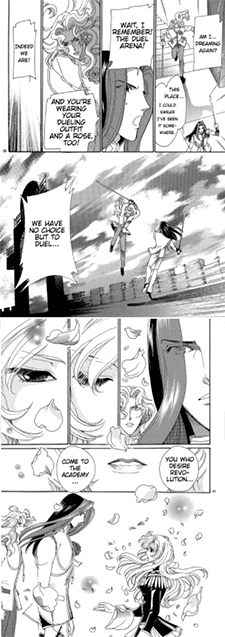 And in doing so, they have finally made the inverted castle appear and themselves as duellists from before. The feelings are familiar but they do not understand why it is so. This scene was so crucial to the entire narrative. Not only is it a scene where two friends are duelling for their philosophies but it is also a duel where Utena is not fighting. Two unlikely candidates, Saionji and Touga are vying to see who can master the other. It is also a bit cyclical to the series. Before Utena appeared, Saionji may have won a set of duels to have Anthy by his side. This duel also cements that Saionji may have always, internally, had something prince-like about him. The argument with Touga of not holding aesthetical value higher portrays him in a princely light as well. It is refreshing to see Saionji not as a caricature but as a force to be reckoned with. Refreshingly, a force of good. A force who possesses high ideals. Which was what a prince was notable for. And in doing so, they have finally made the inverted castle appear and themselves as duellists from before. The feelings are familiar but they do not understand why it is so. This scene was so crucial to the entire narrative. Not only is it a scene where two friends are duelling for their philosophies but it is also a duel where Utena is not fighting. Two unlikely candidates, Saionji and Touga are vying to see who can master the other. It is also a bit cyclical to the series. Before Utena appeared, Saionji may have won a set of duels to have Anthy by his side. This duel also cements that Saionji may have always, internally, had something prince-like about him. The argument with Touga of not holding aesthetical value higher portrays him in a princely light as well. It is refreshing to see Saionji not as a caricature but as a force to be reckoned with. Refreshingly, a force of good. A force who possesses high ideals. Which was what a prince was notable for.
In the midst of such a duel, the unexpected happens. We, the readers, are wonderfully surprised. For now, taking the place of Dios, is Utena herself. Just as Dios believed in Utena’s power in being a prince, she too believes in Touga and Saionji to make the right decisions. To be princes in their own rights. Due to Utena’s belief in them, Saionji and Touga stop their heated battle and return to the world. Saionji is surprised to see Touga crying but he tries to hide it.
Touga’s tears are a testament to the fact that he still holds Utena dear to his heart. She is an irreplaceable; an entity whose presence does not necessitate an utterance. Such as Utena did not need to name Dios to know he was important. It is in this stead Saito weaves into the present narrative the importance of past narratives. Utena allows Saionji and Touga to “revolutionise the world” in the similar pattern Dios and Anthy had allowed her to. In this manner, Utena has become the Dios of this new stage. She is not only his successor and heir but also the successor and heir to Anthy. By the end of the manga, the swords of hatred had branded her as a new witch. Thus, Utena persists with the label as both prince and witch of the new arena. However, she holds the power of integrity and purity that reminds Touga of his “old” self or rather his “true” self. The self that is similar to Utena promising to save Anthy. As a child, Touga had also promised to witness a miracle such as Saionji wished to have the secret to the miracle he believed was Touga’s. 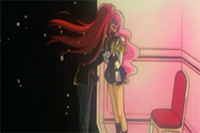 The scene is juxtaposed with the childhood of Utena in Adolescence Apocalypse only with the places reversed. It is not Utena here who must reconcile with her childhood and remember a defining yet amnesiac past, rather, it is Touga. Utena had to rid herself of the memory of her past ruining her present and probable future, or rather treating her past as a failure. The scene is juxtaposed with the childhood of Utena in Adolescence Apocalypse only with the places reversed. It is not Utena here who must reconcile with her childhood and remember a defining yet amnesiac past, rather, it is Touga. Utena had to rid herself of the memory of her past ruining her present and probable future, or rather treating her past as a failure.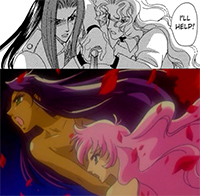 Similarly, Touga should not encounter his memory of meeting Utena in her coffin and feeling he didn’t grow up as an ideal, her ideal, and is a failure. He still has the chance to make amends and be the person he was destined to be. He still has a chance to be a prince. Utena is to Touga as Dios was to Utena. Saito cleverly makes a parallel between Anthy and Utena to Saionji and Touga and she does it expertly. Similarly, Touga should not encounter his memory of meeting Utena in her coffin and feeling he didn’t grow up as an ideal, her ideal, and is a failure. He still has the chance to make amends and be the person he was destined to be. He still has a chance to be a prince. Utena is to Touga as Dios was to Utena. Saito cleverly makes a parallel between Anthy and Utena to Saionji and Touga and she does it expertly.
After regaining his bearings, Touga and Saionji prepare to enter the place that houses “The Revolution.” And they do it together, sword clasped. The scene’s relevance cannot be replaced. It is quite similar to another scene that had unfolded years ago, in another setting, for another revolution.
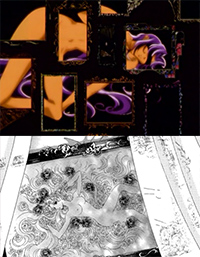
Saionji and Touga are paralleling Utena and Anthy in their final understanding what freedom meant. Once they enter the room they are surprised to find “The Revolution.” It echoes the same venom that Adolescence Apocalypse evoked. There is a picture of Anthy naked, which is not completely in good taste. Not only that, Akio appears and reveals what is the true nature of his word “protect.” Akio does not wish to part with this picture of Anthy. Thus, his understanding of “protect” evokes the same thing that Akio had uttered in the movie — he wishes Anthy to be his living corpse and stay “immaculate” to his standards in this painting.
Akio then attacks and wounds Saionji. Seeing Saionji hurt truly alarms Touga and then he asks for “the power to revolutionise the world.” It is now not the spirit of Dios but the spirit of Utena that comes forth and finally helps Touga put the sword right back into Akio. After that Akio vanishes and the portrait changes. It transforms into something with meaning and it screams the colours of freedom and love. Similar to how we last left Utena and Anthy.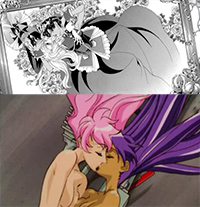
Touga explains that perhaps they were just called upon by the prince (Utena) to help her save the girl in the painting (Anthy). And, they have succeeded in that endeavour. Saionji is stubborn to receive Touga’s help yet Touga supports him. We can see that Saito juxtaposed these two images for a purpose.
We can see the analogous positionality of Saionji and Touga to Utena and Anthy. Utena and Anthy did not specifically start a harmonious relationship, an effect more overtly shown in the movie. However, they became very dear to each important. They became best of friends and each other’s true love. This is a very important analogy. The feelings and emotions Utena and Anthy shared have now concatenated to the others, especially to Saionji and Touga. I do not believe this is a coincidence nor is it just happenstance. Even if it was not designed years ago it does fit cyclically (like a revolution) with the elements of the preceding series.
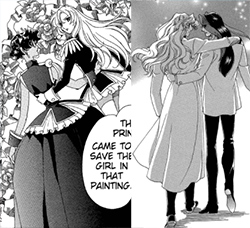
In the movie, when Wakaba turned into a car, Juri explained that one day a time will come when they may as well travel to the fated outside world. The time for Saionji and Touga had come. The adult world is filled with complications and complexities that our adolescences cannot always compute. Our adolescences in itself become murky and distant as we grow older. Saito has shown the places of the puzzle that fits. The distance between Touga and Saionji can only be resolved by Anthy and Utena as they seem to parallel one another. Both were too stubborn to admit it but the truth did come out.
It should also be noted that Saionji had once stated that in the outside world he would seduce Anthy. None of that happened. Saionji turned out to be a meticulous and moralistic man who looked at Touga’s womanising and need for profit as “filthy.” This manga really matured Saionji from being ill-tempered and self-centred to a more empathetic and copacetic person overall. He had a sense of duty and purpose and had desires, simple as Utena’s, but very treasurable and valuable. It is Touga that turned out a bit bitter. Akin to Professor Nemuro and Akio he just fashioned getting prospective deals. It takes Utena’s memory and Saionji’s life being in danger to make his withdrawn self to finally come out.
The sword also is an important symbol in this manga. We see that when Akio appears and tries to “protect” the sword makes him vanish. It is as if Utena has been been fighting off Akio all this time so that his twisted ideals of accomplishment and reality do not erode and cause calamity in the world. In this battle, she has shown to be more stable and focused than Dios. The difference being that Utena and Dios may both pine to be princes but Utena is ready to make the relevant sacrifices for them. She is willing to do her job bloodied and bruised and not only sit on a casket or throne of gold and proclaim herself a winner. Dios/Akio may only look at the glory and the superficial wealth that comes from being a prince but they are always ready in doing the actual work of it. Utena is and that is why she still possesses the power to revolutionise the world.
The idea for me in this manga is that each of the characters in the Utena universe could be a prince in their own right as long as they stay true to themselves. Also, I wonder if the series will use a “couplet” or “couples” approach in storytelling. Will we get Juri and Ruka next? Or, Juri and Miki? Nanami and Wakaba? I have questions on those criteria. There are also the added questions of how this ties to the structure of the manga and anime series. Was Utena then unable to be the “calyx” for Akio? Was Akio so self-deluded in being a prince that he captured Anthy once again? And, in doing so, erased even the faintest traces of Dios? This could explain why Utena is now the new Dios. Not that she wouldn’t be without such a reason. When Utena freed Anthy from her coffin and took the swords of hatred she had become victor to the crucible which Akio could not be. She had faced the public and proclaimed love to her dearest and shown the audience that her dearest holds to her utmost importance. She refused to be a people pleaser, like Akio, and decided to stand up for nobility and justice.
In this manga, after 20 years, Touga too decided to take a similar stand. When he attacks Akio, he is also attacking his own insecurities and people pleasing attitude. He has decided to stand up for what is right. Most importantly, he is also declaring his love for Saionji. Though he mocked him earlier Saionji has always been a compass to Touga. A compass of dedication and loyalty. Touga’s disdain for Saionji came solely because he could not, at the moment in the series, return such a gift. The behaviour felt “parasitic” to him only because he was being parasitic to Saionji. He did not wish to treasure Saionji because that would outright declare his vulnerability to the world. That he needs Saionji. That he wants him too. Finally, he is old enough to accept these emotions. When he attacks Akio, he is in turn attacking Akio’s and his own vices. The inability to proclaim the mutuality of love and rather tarnishing it into some weird possession and obsession.
Akio’s “love” for his sister was merely to objectify her and treat her as trophy painting. Utena was freed from depending on Dios by Anthy and in turn frees Anthy from Akio. Their parallel is Saionji and Touga in this instalment. Touga is able to break free of the ferrers that keeps his affections and also his humanity “in check.” He is able to protect Saionji and understand his feelings for him. He does not despise Saionji’s “naivety.” He rather did not know how to respond to it or how to give it a suitable answer that would be concomitant to his character.
His character had lacking. A position that Utena herself once realised when she could not always understand Anthy or even when Juri is pained by Shiori. Akio’s answer to her at that time was Utena possessed an innocence in the situation that could be akin to cruelty. In Touga’s case, it is not innocence, not necessarily indifference, but ignorance. Touga understood Nanami’s dedication as familial bonds. Saionji’s loyalty was not necessarily sexual. It was also pretty social and platonic. Saionji treated Touga as a rival but did not outright hate him. Rather he trusted him enough with his personal belongings and feelings. This was confusing to someone like Touga who believed a means to an end rather than just enjoying an interaction in and of itself. In Saionji, he sees this and it is frightening. It takes adulthood with its own twists and turns for Touga to accept the breadth and width of Saionji’s loyalty with the maturation of his own emotions. Touga has realised that Saionji is also an irreplaceable. The power to revolutionise the world is that: the ability to realise that someone you have unparalleled bonds with. For Touga, it is Saionji.
 |

